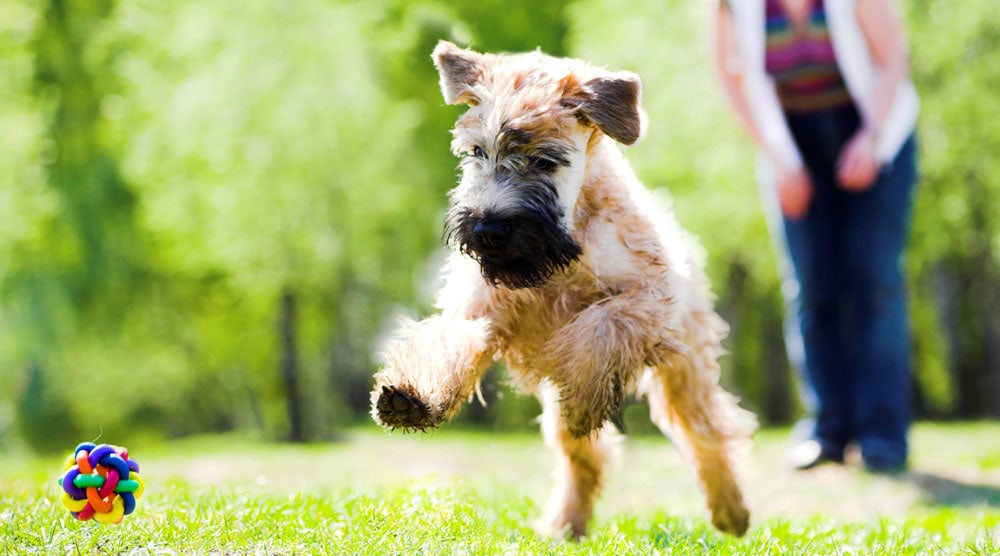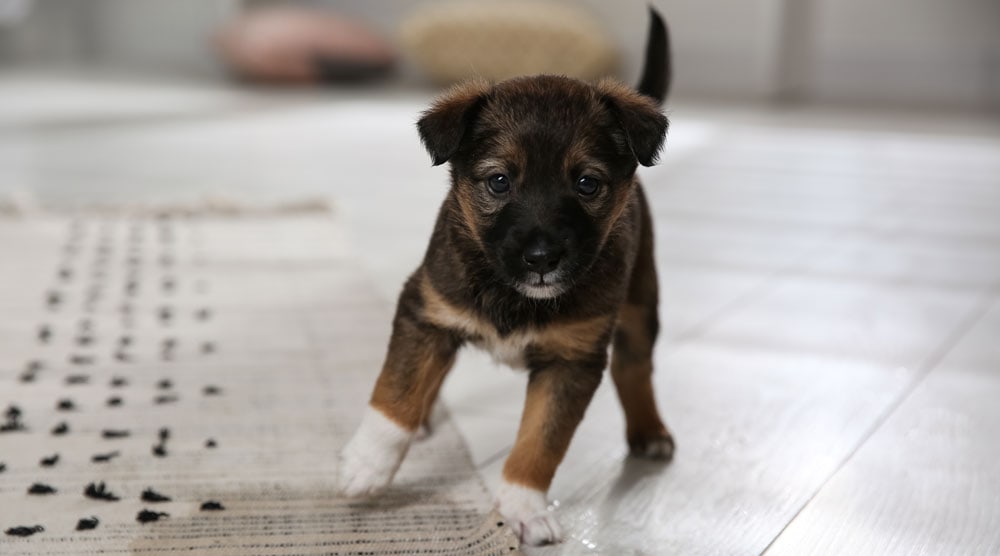Fake grass pads can be an alternative to taking your dog outdoors to pee, especially if you live in a tall apartment block or don’t have a private garden.
Grass pads shouldn’t replace walks for dogs in apartments, but they are more convenient than taking your pet downstairs every few hours. They can also be helpful for potty training a puppy in an apartment, as you can use them at night.
Of course, fake grass pee pads are only useful if your dog knows to use them! Even though they look like grass, your dog won’t instinctively understand to pee on them. Instead, you need to teach them using positive reinforcement.
How to Teach Your Dog to Pee on Fake Grass

The key to teaching your dog to pee on fake grass is to give them lots of opportunities to get it “right”, followed by plenty of praise and rewards when they go in the correct place. Over time, this teaches the dog that toileting on the grass pad is positive.
You can apply the training steps below to any dog, including older pups. It’s essential to be patient though. It can take time for a dog to learn to pee on an indoor pad, particularly if they’ve previously been trained to only toilet outdoors.
Step 1: Choose an Appropriate Location and Size for the Grass Pad
Before you start training your dog, the first step is to decide where you want the pad to be placed.
This is an important decision, as you don’t want to move the pad during the training process. Dogs are contextual learners, so they may regress in training if the pad is moved to a different location.
Here are some tips for choosing the best location for a grass pee pad:
- The location should be quiet with minimal distractions
- If possible, place the pad on a hard floor so it’s easier to clear up any accidents or misses
- Try to put the mat next to a wall, as this limits the number of directions the dog can wander off during the training
- Consider putting a pen around the fake grass to prevent misses and limit distractions
Aside from the location, it’s also vital that the pad is big enough.
As you’ve probably noticed, most dogs need a “runway” before going for a pee. They are also quite particular about where they go, as dogs use their pee for scent marking.
For these reasons, it’s much harder to teach a dog to pee on a fake grass pad if it’s too small. While big adult dogs need the most space, even puppies like to have a choice about where they go for a pee.
It’s a good idea to place multiple pads together when you first start training. The goal is to make the pad as big as possible for the location you’re using. Once your dog understands how to use the pee pads, you can try reducing the size if necessary.
Tip: It might sound unpleasant, but you can make a pad more attractive for dogs by scattering a few sticks or leaves they’ve already peed on. Dogs are heavily scent-focused, so these objects may encourage them to go for a pee on the pad.
Step 2: Teach Your Dog to be Comfortable Walking on Artificial Grass
The next step is ensuring your dog is comfortable walking on the grass pad. Your dog needs to feel relaxed on the artificial grass if you want them to pee on it, so don’t skip this step.
Once you’ve placed the mat, put some treats on it and allow your dog to sniff and explore it. Don’t force your dog to go on the grass mat – allow them to do so in their own time.
Keep repeating this process until your dog is happy to walk on the pad and doesn’t show any reluctance to go near it. This can take time, but it’s important not to rush the process.
However, you shouldn’t play with your dog on the fake grass, or actively give them treats from your hand. This could make the next steps more difficult, as the dog will be hoping for a treat or a game, rather than being focused on going to the toilet.
Step 3: Give Your Dog Frequent Chances to Pee on The Grass Pad
Now that the pad is in the correct position, is big enough, and your dog is happy to walk on it, the real training can begin!
The goal is to give your dog every opportunity to go to the toilet on the grass pad. That means taking them to the pad whenever they would usually need to go. Make sure there are no distractions when they are on the fake grass, such as treats or toys, as you don’t want your pet to be distracted.
Here are some guidelines for how often you should take your dog to the pad:
- For puppies, you’ll need to take them to the grass pad regularly, including after every meal or when they wake up from a nap. You should also watch for circling, sniffing, or other signs that they need to pee.
- For housetrained adult dogs, take your dog to the pee pad first thing in the morning, last thing at night, and at least every few hours during the day.
When you’re getting started with training, take your dog to the fake grass more often than you think is necessary. Give your dog plenty of chances to succeed, while also minimising accidents that could cause setbacks in the training process.
On the other hand, don’t panic if your dog doesn’t go to the toilet immediately. If you’ve been waiting for a few minutes without success, try again in 20-30 minutes.
How can you ensure your dog remains on the fake grass while you’re waiting though?
This is where having a pen around the grass can be helpful. By confining your dog to the pee pad when they likely need the toilet, you greatly increase your chances of success.
If enclosing your dog isn’t an option, you can use a leash to keep them on the pee pad. However, this can feel restrictive to the dog, which may interfere with them going to the toilet.
Step 4: Reward and Praise Your Dog for The Desired Behaviour
When your dog successfully goes for a pee on the fake grass, give them praise and treats. This reinforces the behaviour and makes your dog more likely to repeat it in the future.
The timing of the treat is the key to success. You should give it immediately after your dog finishes, so they link it with the correct behaviour. But be careful not to give the treat while your dog is still toileting, as this can distract them and mean they don’t fully empty their bladder.
It’s also a good idea to train a verbal cue. Every time your dog starts going to the toilet, say the cue phrase (such as “get busy” or “be clean”) so that they start to associate the cue with toileting.
Keep doing this for several weeks before using the cue to ask your dog to go to the toilet. If you use it too soon, your dog won’t have linked the cue with the action.
Important: Never punish or scold your dog for accidents or “misses.” This can damage your bond and cause your dog to become anxious when toileting.
Step 5: Remove Pen or Leash
Once your dog consistently pees on the grass pad when you take them to it, the next step is to reinforce that they should go to it independently.
Remove the pen or any barriers around the grass pad (or don’t attach a leash if that’s what you’ve been using). Whenever you think it’s time for them to go to the toilet, call them onto the mat and stand with them. Give the dog treats and praise after they go to the toilet in the right place.
You should also watch your dog closely throughout the day. If you notice them going for a pee on the grass pad without your prompting, give them praise and treats. When your dog does this consistently, they’ve been fully trained to pee on the fake grass. Congratulations!
Troubleshooting Tips
Dog training isn’t always linear. Some dogs make consistent progress, while others seem to stall, or even go backwards at times.
This is completely normal and there is usually a simple solution. Here are some common issues and how to start moving forwards again:
- Dog is reluctant to step on the mat. In this case, you need to go back to step two, as there’s no way to teach a dog to pee on fake grass if they are scared to tread on it. Practice placing treats around the mat and allow your dog to explore it in their own time.
- Occasional misses. It’s unavoidable that sometimes a dog will miss the mat. This is more likely with “leg lifters”, but will happen to all dogs occasionally. You can reduce the chance by combining several mats to make the target area bigger. Placing barriers on two or three sides of the mat can also reduce the chance of the dog trying to pee at the edge of the grass.
- Dog pees on the fake grass when taken to the mat, but doesn’t go there without prompting. Patience is the key in this situation. Keep taking your dog to the mat and giving treats after they go to the toilet. It may take time for the habit to become fully ingrained.
- Dog stops going on the mat after you thought they were fully trained. There are several potential reasons for this. The most likely is that your dog’s training wasn’t quite ready for the next step, so you may need to go back to prompting to re-establish the habit. You may also need to clean the artificial grass, as a strong urine smell can be off-putting to a dog.
Summary
Almost any dog can be trained to pee on fake grass, regardless of their age. This type of toilet training can be a long process though, so you need to be patient with your pet.
Do you have any questions about how to train a dog to pee on fake grass? Please let us know in the comments section.



